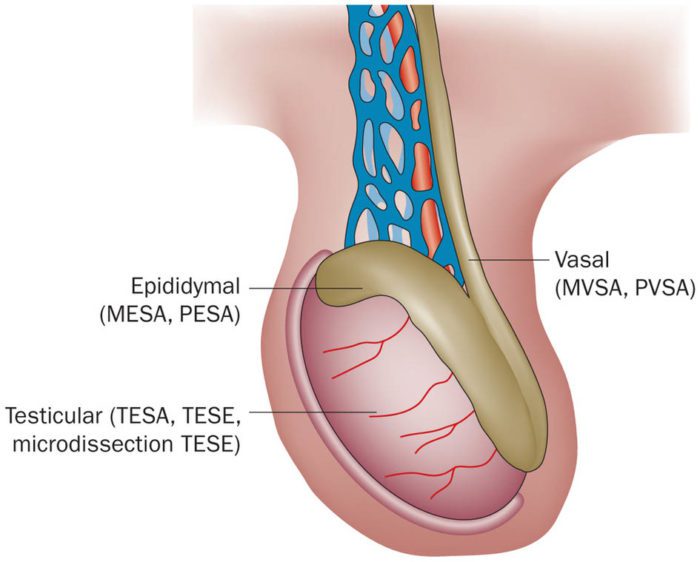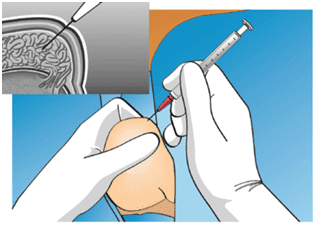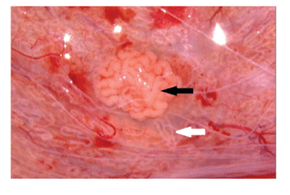
What are these TESA and PESA procedures?
Some of the causes of male infertility are non availability of normal viable sperms in the ejaculate for IVF treatment.
Some of the reasons could be:
- Azoospermia (No sperms),
- Low sperm count (Oligospermia),
- Low sperm motility (asthenospermia).
Tesa and Pesa treatment includes the procedures to recover sperms through the minor medical surgical process.
Sperm Extraction Procedures:
PESA (Percutaneous Epididymal Sperm Aspiration)
PESA treatment is a surgical procedure which involves the use of needle and syringe technique as for a needle biopsy, but the needle is directly placed into the epididymis. This often gives good results if there is a blockage in the vas deferens but the testis is producing sperms.


TESA (Testicular Sperm Aspiration) and TESE
(Testicular Sperm Extraction)
TESA Treatment is similar to a needle biopsy but involves placing a needle attached to a syringe through the skin of the scrotum, and simply sucking out the fluid from the testicle.
- TESE (Testicular sperm extraction)– This involves opening up the scrotum and taking a large volume of testicular tissue, perhaps from several regions of the testicle. Sperms are then retrieved with the help of a microscope to collect individual sperms sperm. This is done under anesthesia.
- MESA (Microsurgical Epididymal Sperm Aspiration)– An open surgical sperm retrieval procedure that uses an operating microscope to locate the tubules of the epididymis precisely, so that large numbers of sperm can be extracted.
Some studies have compared the success rates after the different types of surgical sperm collection procedures. These studies concluded that MESA treatment which gives the highest number of sperm, with a hundred times more sperm being recovered compared to TESA and percutaneous biopsy. MESA also produced sperm that was better swimmers and therefore more useful for infertility treatments, including IVF and ICSI.

 These alternative methods of retrieving sperm allow male patients to use their own sperm in the IVF/ICSI procedure. The procedures themselves are not very costly and offer the chance to couples and avoid the cost of using a sperm donor. At the Delhi IVF, we are committed to offering the most cost-effective treatment. Some men do not have sperm at all or only few in numbers and that too of poor quality. In such cases, the sperm has to be aspirated directly from their testicles (TESA) or from the epididymis that stores the sperm prior to an ejaculation (PESA, MESA).
These alternative methods of retrieving sperm allow male patients to use their own sperm in the IVF/ICSI procedure. The procedures themselves are not very costly and offer the chance to couples and avoid the cost of using a sperm donor. At the Delhi IVF, we are committed to offering the most cost-effective treatment. Some men do not have sperm at all or only few in numbers and that too of poor quality. In such cases, the sperm has to be aspirated directly from their testicles (TESA) or from the epididymis that stores the sperm prior to an ejaculation (PESA, MESA). Micro TESE – With advancement in technology, we have several sperm retrieval methods at Delhi-IVF. Sperms can be easily found in more than half the number of men with non-obstructive azoospermia (NOA). Micro TESE, Microsurgical testicular sperm extraction is a procedure that is performed to remove small volumes of testicular tissues in the areas of active sperm production with the help of a microscope, thus, improving sperm yield. This approach has several advantages as compared to the other sperm retrieval methods. It maximizes the production of spermatozoa while reducing the amount of testicular tissue needed and reducing vascular injury with the help of microscope.
Micro TESE – With advancement in technology, we have several sperm retrieval methods at Delhi-IVF. Sperms can be easily found in more than half the number of men with non-obstructive azoospermia (NOA). Micro TESE, Microsurgical testicular sperm extraction is a procedure that is performed to remove small volumes of testicular tissues in the areas of active sperm production with the help of a microscope, thus, improving sperm yield. This approach has several advantages as compared to the other sperm retrieval methods. It maximizes the production of spermatozoa while reducing the amount of testicular tissue needed and reducing vascular injury with the help of microscope. Your Journey to Parenthood Begins with us!
Your Journey to Parenthood Begins with us!